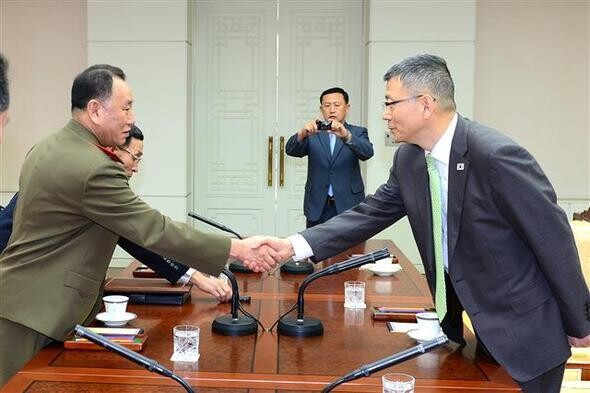hankyoreh
Links to other country sites 다른 나라 사이트 링크
Will this month’s high-level inter-Korean talks get off the ground?

By Choi Hyun-june, staff reporter
A major crossroads is looming for inter-Korean dialogue. Nearing two full years in office, many are saying the Park Geun-hye administration in Seoul needs to seize the opportunity if it hopes to make any lasting accomplishments in relations with Pyongyang.
South and North met on Oct. 15 for military talks, where they skirmished over the two major problem areas of late: the Northern Limit Line (NLL) in the West (Yellow) Sea and the launching of balloons carrying propaganda leaflets into North Korea. Little came of the meeting, but it was a significant step in terms of keeping up momentum for dialogue after an Oct. 4 visit to Incheon by a group of three core members of North Korea’s leadership, including People’s Army general political bureau chief Hwang Pyong-so.
“The NLL and the leaflets aren’t issues that can be resolved in one meeting,” said Kim Chang-soo, chief of research for the Korea National Strategy Institute. “It‘s significant enough that South and North Korea had their first military talks in 44 months.”
It’s too soon to tell if the dialogue push will lead to a second round of high-level talks. Analysts are saying the possibility is still alive, especially in light of political and economic factors pushing both sides in the direction of dialogue.
But some are also arguing Seoul‘s proposed date of Oct. 30 may not be realistic. To begin with, the leaflet launches by North Korean refugee groups in South Korea could push Pyongyang to cancel. While the Park administration may have adopted a more forward-thinking attitude than in the past, it has yet to show any kind of commitment to cracking down on the launches. Meanwhile, Pyongyang remains very sensitive about an issue it says insults its “supreme dignity.”
Another potential roadblock is the South Korea-US Security Consultative Meeting scheduled for Oct. 23 to 25. Topics on the agenda there could include the transfer of wartime operational control to South Korea and the Terminal High Altitude Area Defense (THAAD) system, a missile defense component. The outcome of the meeting could affect Pyongyang’s response.
“The reason North Korea proposed holding the senior talks in late October or early November is precisely because it was thinking about the Security Consultative Meeting,” said Chang Yong-seok, a senior researcher at the Seoul National University Institute for Peace and Unification Studies.
“That’s definitely a mountain we have to get over if the second round of high-level talks are going to get off the ground,” Chang predicted.
South Korea’s planned “Chungmu” military exercises, scheduled for Oct. 30, could also push Pyongyang to ask for a different date. The comprehensive wartime preparation exercises, which were first held in 1982, are not large-scale events like South Korea‘s joint exercises with the US, but they do incorporate military support resources.
“There are a lot of potential obstacles, with the leaflets, the Northern Limit Line, and the Security Consultative Meeting,” said Kim Chang-soo.
“If we’re going to get through this, we need President Park Geun-hye to send a message of conciliation to the North,” he advised.
On Thursday, North Korea‘s Korean Central News Agency released a report on the proceedings of the North-South military meetings on Wednesday. They attributed the meeting’s lack of results to what they called the South‘s “insolent attitude”.
They referred to President Park as South Korea’s “power holder”, much milder language than the insults they‘ve used to describe her in the past.
Please direct questions or comments to [english@hani.co.kr]

Editorial・opinion
![[Column] Has Korea, too, crossed the Rubicon on China? [Column] Has Korea, too, crossed the Rubicon on China?](https://flexible.img.hani.co.kr/flexible/normal/500/300/imgdb/original/2024/0419/9317135153409185.jpg) [Column] Has Korea, too, crossed the Rubicon on China?
[Column] Has Korea, too, crossed the Rubicon on China?![[Correspondent’s column] In Japan’s alliance with US, echoes of its past alliances with UK [Correspondent’s column] In Japan’s alliance with US, echoes of its past alliances with UK](https://flexible.img.hani.co.kr/flexible/normal/500/300/imgdb/original/2024/0419/2317135166563519.jpg) [Correspondent’s column] In Japan’s alliance with US, echoes of its past alliances with UK
[Correspondent’s column] In Japan’s alliance with US, echoes of its past alliances with UK- [Editorial] Does Yoon think the Korean public is wrong?
- [Editorial] As it bolsters its alliance with US, Japan must be accountable for past
- [Guest essay] Amending the Constitution is Yoon’s key to leaving office in public’s good graces
- [Editorial] 10 years on, lessons of Sewol tragedy must never be forgotten
- [Column] A death blow to Korea’s prosecutor politics
- [Correspondent’s column] The US and the end of Japanese pacifism
- [Guest essay] How Korea turned its trainee doctors into monsters
- [Guest essay] As someone who helped forge Seoul-Moscow ties, their status today troubles me
Most viewed articles
- 1[Column] The clock is ticking for Korea’s first lady
- 2After 2 months of delayed, denied medical care, Koreans worry worst may be yet to come
- 3Hong Se-hwa, voice for tolerance whose memoir of exile touched a chord, dies at 76
- 4Samsung barricades office as unionized workers strike for better conditions
- 5[Column] Has Korea, too, crossed the Rubicon on China?
- 6US overtakes China as Korea’s top export market, prompting trade sanction jitters
- 7[Editorial] As it bolsters its alliance with US, Japan must be accountable for past
- 8[Correspondent’s column] In Japan’s alliance with US, echoes of its past alliances with UK
- 9All eyes on Xiaomi after it pulls off EV that Apple couldn’t
- 10[Guest essay] How Korea turned its trainee doctors into monsters